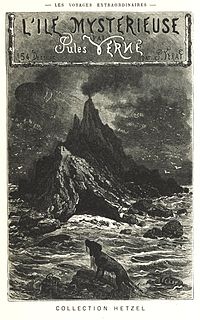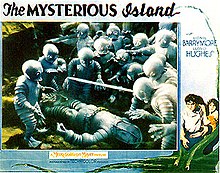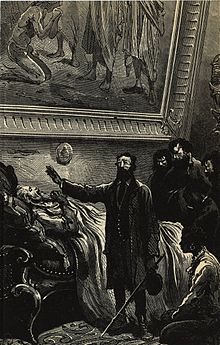The Mysterious Island: Difference between revisions
The Mysterious Island - Wikipedia, the free encyclopedia |
|||
| Line 27: | Line 27: | ||
==Plot summary== |
==Plot summary== |
||
The book tells the adventures of five Americans on an uncharted island in the [[Australasia|South Pacific]]. The story begins in the [[American Civil War]], during the siege of [[Richmond, Virginia]], the capital of the [[Confederate States of America]]. As famine and death ravage the city, five northern prisoners of war decide to escape by the unusual means of hijacking a balloon. |
The book tells the adventures of five Americans on an uncharted island in the [[Australasia|South Pacific]]. The story begins in the [[American Civil War]], meow |
||
during the siege of [[Richmond, Virginia]], the capital of the [[Confederate States of America]]. As famine and death ravage the city, five northern prisoners of war decide to escape by the unusual means of hijacking a balloon. |
|||
<!-- Please note: the names are correcriginal --> |
<!-- Please note: the names are correcriginal --> |
||
The escapees are [[Cyrus Smith]], a [[railroad]] [[engineer]] in the [[Union (American Civil War)|Union]] army (named Cyrus Harding in some English translations); his black [[manservant]] [[Neb]] (short for [[Nebuchadnezzar]]), a former slave who had been freed by Smith; the sailor [[Bonadventure Pencroff]] (who is addressed only by his surname, but his "Christian name", Bonadventure, is given to their boat; in other translations, he is also known as Pencroft); his [[protégé]] [[Harbert Brown]] (called Herbert in some translations), a young boy whom Pencroff raises as his own after the death of his father (Pencroff's former captain); and the [[journalist]] [[Gedéon Spilett]] (Gideon Spilett in English versions). The company is completed by Cyrus' dog "Top".{{Ref|orig-names}} |
The escapees are [[Cyrus Smith]], a [[railroad]] [[engineer]] in the [[Union (American Civil War)|Union]] army (named Cyrus Harding in some English translations); his black [[manservant]] [[Neb]] (short for [[Nebuchadnezzar]]), a former slave who had been freed by Smith; the sailor [[Bonadventure Pencroff]] (who is addressed only by his surname, but his "Christian name", Bonadventure, is given to their boat; in other translations, he is also known as Pencroft); his [[protégé]] [[Harbert Brown]] (called Herbert in some translations), a young boy whom Pencroff raises as his own after the death of his father (Pencroff's former captain); and the [[journalist]] [[Gedéon Spilett]] (Gideon Spilett in English versions). The company is completed by Cyrus' dog "Top".{{Ref|orig-names}} |
||
Revision as of 00:39, 27 October 2013
34°57′S 150°30′W / 34.950°S 150.500°W
This article needs additional citations for verification. (March 2010) |
 | |
| Author | Jules Verne |
|---|---|
| Original title | L'Île mystérieuse |
| Translator | Agnes Kinloch Kingston and W. H. G. Kingston (1875) Stephen W. White (1876) I. O. Evans (1959) Lowell Bair (1970) Sidney Kravitz (2001) Jordan Stump (2001) |
| Illustrator | Jules Férat |
| Language | French |
| Series | The Extraordinary Voyages #12 |
| Genre | Adventure novel |
| Publisher | Pierre-Jules Hetzel |
Publication date | 1874 |
| Publication place | France |
Published in English | 1874 |
| Media type | Print (Hardback) |
| ISBN | N/A Parameter error in {{ISBNT}}: invalid character |
| Preceded by | Around the World in Eighty Days |
| Followed by | The Survivors of the Chancellor |
The Mysterious Island (French: L'Île mystérieuse) is a novel by Jules Verne, published in 1874. The original edition, published by Hetzel, contains a number of illustrations by Jules Férat. The novel is a crossover sequel to Verne's famous Twenty Thousand Leagues Under the Sea and In Search of the Castaways, though thematically it is vastly different from those books. An early draft of the novel, initially rejected by Verne's publisher and wholly reconceived before publication, was titled Shipwrecked Family: Marooned With Uncle Robinson, seen as indicating the influence on the novel of Robinson Crusoe[1] and The Swiss Family Robinson.[2]
Plot summary
The book tells the adventures of five Americans on an uncharted island in the South Pacific. The story begins in the American Civil War, meow during the siege of Richmond, Virginia, the capital of the Confederate States of America. As famine and death ravage the city, five northern prisoners of war decide to escape by the unusual means of hijacking a balloon. The escapees are Cyrus Smith, a railroad engineer in the Union army (named Cyrus Harding in some English translations); his black manservant Neb (short for Nebuchadnezzar), a former slave who had been freed by Smith; the sailor Bonadventure Pencroff (who is addressed only by his surname, but his "Christian name", Bonadventure, is given to their boat; in other translations, he is also known as Pencroft); his protégé Harbert Brown (called Herbert in some translations), a young boy whom Pencroff raises as his own after the death of his father (Pencroff's former captain); and the journalist Gedéon Spilett (Gideon Spilett in English versions). The company is completed by Cyrus' dog "Top".[1]
After flying in stormy weather for several days, the group crash-lands on a cliff-bound, volcanic, unknown (and fictitious) island, described as being located at 34°57′S 150°30′W / 34.950°S 150.500°W, about 2,500 kilometres (1,600 mi) east of New Zealand. (In reality, the closest island is Marotiri, located at 27°55′S 143°26′W / 27.917°S 143.433°W. In location and description though, the phantom island Ernest Legouve Reef may correspond to the rock that is left of the mysterious island at the end of the novel.) They name it "Lincoln Island" in honor of American President Abraham Lincoln. With the knowledge of the brilliant engineer Smith, the five are able to sustain themselves on the island, producing fire, pottery, bricks, nitroglycerin, iron, a simple electric telegraph, a home on a stony cliffside called "Granite House", and even a seaworthy ship. They also manage to figure out their geographical location.

During their stay on the island, the group endures bad weather, and adopts and domesticates an orangutan, Jupiter, abbreviated to Jup (or Joop, in Jordan Stump's translation).
There is a mystery on the island in the form of an unseen deus ex machina, responsible for Cyrus' survival after falling from the balloon, the mysterious rescue of Top from a dugong, the appearance of a box of equipment (guns and ammunition, tools, etc.), the delivery of a distress message from another island, and other seemingly inexplicable occurrences.
The group finds a message in a bottle directing them to rescue a castaway on nearby Tabor Island, Tom Ayrton (from In Search of the Castaways). On the return voyage to Lincoln Island, they lose their way in a tempest but are guided back to their course by a mysterious fire beacon.
Ayrton's former crew of pirates arrives at Lincoln Island to use it as their hideout. After some fighting with the protagonists, the pirate ship is mysteriously destroyed by an explosion. Six of the pirates survive and fire upon Harbert, seriously injuring him. They pose a grave threat to the colony, but suddenly the pirates are found dead, apparently in combat, but with no visible wounds. Harbert contracts malaria and is saved by a box of sulphate of quinine, which mysteriously appeared on the table in the Granite House.
The secret of the island is revealed when it is discovered to be Captain Nemo's hideout, and home port of the Nautilus. Having escaped the Maelstrom at the end of Twenty Thousand Leagues Under the Sea, the Nautilus sailed the oceans of the world until all its crew except Nemo had died. Now an old man with a beard, Nemo returned the Nautilus to its secret port within Lincoln Island. Nemo who had been the savior of the heroes, providing them with the box of equipment, sending the message revealing Ayrton, planting the mine that destroyed the pirate ship, and killing the pirates with an "electric gun". On his death bed Captain Nemo reveals his true identity as the lost Indian Prince Dakkar, son of a Raja of the then independent territory of Bundelkund and a nephew of the Indian hero Tippu-Sahib. After taking part in the failed Indian Rebellion of 1857, Prince Dakkar escaped to a deserted island with twenty of his compatriots and commenced the building of the Nautilus and adopted the new name of "Captain Nemo". Nemo tells his life story to Cyrus Smith and his friends and then dies, crying "God and my country!" The Nautilus is scuttled and serves as Captain Nemo's tomb.[2]
Afterward, the island's central volcano erupts, destroying the island. Jup the orangutan falls into a crack in the ground and dies. The colonists, forewarned of the eruption by Nemo, find themselves safe but stranded on the last remaining piece of the island above sea level. They are rescued by the ship Duncan, which had come to rescue Ayrton but were redirected by a message left on Tabor Island by Nemo.
Publication history in English
In September 1875 Sampson Low, Marston, Low, and Searle published the first British edition of Mysterious Island in three volumes entitled Dropped from the Clouds, The Abandoned, and The Secret of the Island (195,000 words). In November, 1875 Scribners published the American edition of these volumes from the English plates of Sampson Low. The purported translator, W. H. G. Kingston, was a famous author of boys' adventure and sailing stories who had fallen on hard times in the 1870s due to business failures, and so he hired out to Sampson Low as the translator for these volumes. However, it is now known that the actual translator of Mysterious Island and his other Verne novels was actually his wife, Agnes Kinloch Kingston, who had studied on the continent in her youth. The Kingston translation changes the names of the hero from "Smith" to "Harding"; "Smith" is a name often used by gypsies and not suitable for an English hero. In addition many technical passages were abridged or omitted and the anti-imperialist sentiments of the dying Captain Nemo were purged so as not to offend English readers. This became the standard translation for more than a century.
In 1876 the Stephen W. White translation (175,000 words) appeared first in the columns of The Evening Telegraph of Philadelphia and subsequently as an Evening Telegraph Reprint Book. This translation is more faithful to the original story and restores the death scene of Captain Nemo, but there is still condensation and omission of some sections such as Verne's description of how a sawmill works. In the 20th century two more abridged translations appeared: the Fitzroy Edition (Associated Booksellers, 1959) abridged by I. O. Evans (90,000 words) and Mysterious Island (Bantam, 1970) abridged by Lowell Blair (90,000 words).
No unabridged translations appeared until 2001 when the illustrated version of Sidney Kravitz appeared (Wesleyan University Press) almost simultaneously with the new translation of Jordan Stump published by Random House Modern Library (2001). Kravitz also translated Shipwrecked Family: Marooned With Uncle Robinson, published by the North American Jules Verne Society and BearManor Fiction in 2011.
2003 Edition of Wrecked On A Reef
This edition in English by F. Raynal has additional appendices by French scholar Dr Christiane Mortelier who presents a convincing case for the influence of Francis Raynal's 19th century publication "Wrecked On A Reef" (originally published in French as "Les Naufrages des Iles Auckland") on Verne's Mysterious Island. Verne read Raynal's account of the wreck of the Grafton (Captain Thomas Musgrave) on the subantarctic Auckland Islands and loosely based his story on this true account of shipwreck, survival, privation, and ultimate rescue. The Grafton was wrecked in the Auckland Islands on 3 January 1864. The crew of five (including Musgrave) survived for 19 months before three of them sailed to Stewart Island (New Zealand) in a boat they had made. The remaining two were rescued. Verne incorporated much of this historical material into his Mysterious Island narrative.
Translations into other languages
The novel has been translated into Marathi by B. R. Bhagwat titled 'निर्जन बेटावरचे धाडसी वीर'. The title roughly translates to 'Brave fighters on a deserted island'. It has a cult following in Maharashtra, a state in India where the official language is Marathi.
Film and television adaptations

- 20,000 Leagues Under the Sea (1916 film): This classic American silent feature combines 20,000 Leagues Under the Sea and The Mysterious Island into a single narrative, shifting back and forth between the Nautilus and the island.
- The Mysterious Island (1929 film): loosely based on the back-story given for Captain Nemo in the novel. It is an American all-color part-talking feature (survives only in black & white form) with talking sequences, sound effects and synchronized music. Filmed as a silent but a talking sequence was added to the beginning and brief talking sequences were integrated into the film. Directed by Lucien Hubbard with Benjamin Christensen and Maurice Tourneur.
- Mysterious Island (1941 film): a USSR production, directed by Eduard Pentslin.
- Mysterious Island (1951 film): directed by Spencer Gordon Bennet.
- Mysterious Island (1961 film): directed by Cy Endfield, also known as Jules Verne's Mysterious Island, featuring special effects from Ray Harryhausen and Herbert Lom as Nemo and a score by Bernard Hermann.
- La Isla misteriosa y el capitán Nemo (L'Île mystérieuse) (1973): directed by Juan Antonio Bardem and Henri Colpi: a TV miniseries featuring Omar Sharif as Captain Nemo.
- Mysterious Island: a Canadian television series that ran for one season in 1995.
- Mysterious Island (2005): a TV movie featuring Patrick Stewart as Captain Nemo which is only loosely based on the novel. Nominated for a Saturn award for best TV presentation.
- Journey to the Mysterious Island: a 2012 film loosely based on the novel, directed by Brad Peyton, done as a sequel to an earlier adaptation of Verne's Journey to the Center of the Earth with Dwayne Johnson taking over the lead role from Brendan Fraser.
- Jules Verne's Mysterious Island - A 2012 cinematic adaptation loosely based on the novel made for the Syfy Channel.
Works inspired by The Mysterious Island

- The 1967 live-action/animated film The Stolen Airship by Czech film maker Karel Zeman is based loosely on Jules Verne's novels Two Years' Vacation and The Mysterious Island.
- The Japanese anime Nadia: The Secret of Blue Water (1990), by Gainax, is partly inspired by the novel.[citation needed]
- The computer game Myst, released 1993, and several locations featured in the game were also inspired by Jules Verne's novel.[3]
- Mysterious Island is also the name of a themed land at Tokyo DisneySea opened in 2001 and features two attractions based on other Jules Verne novels, 20,000 Leagues Under the Sea and Journey to the Centre of the Earth.
- The 2002 novel Captain Nemo: The Fantastic History of a Dark Genius has the events of this novel based on 'real' events that occurred to the real Nemo, Andre, who gave the details of his encounters to Verne.
- The computer game Return to Mysterious Island (2004) is an adventure game sequel to the story. Its heroine, Mina, is shipwrecked alone on the uncharted island, and finds the body of the previous inhabitant, Captain Nemo (whom she buries). She finally escapes by locating the Nautilus and disabling the island's defenses.[4] This game was followed in 2009 by Return to Mysterious Island II.[5]
- The creator of the American television program Lost, which aired 2004 to 2010, credits The Mysterious Island as the chief inspiration of the show.
- The Mysterious Island from Saddleback's Illustrated Classics is an 2006 illustrated classroom text to teach reading skills.[6]
Notes
- ^ In the French original, some characters were named a little differently: Gédéon Spillet, Nabuchodonosor (Nab) and Harbert Brown. In the Kingston translation, the engineer is named Cyrus Harding, and the sailor is named Pencroft.
- ^ There are discrepancies in continuity between this novel and Twenty Thousand Leagues Under the Sea. Although this novel was written in 1874, its events take place from 1865 to 1869. The events of Twenty Thousand Leagues Under the Sea take place between 1867 and 1868. For example, the Captain Nemo appearing in this novel dies at a time when the Captain Nemo in Twenty Thousand Leagues Under the Sea was still alive. There is usually a note in most editions of the book admitting date discrepancies.
References
- ^ "Jules Verne: An Author Before His Time?"
- ^ Science Fiction Studies, "Books in Review, July 2002
- ^ wired.com
- ^ mysteriousislandgame.com
- ^ mysteriousislandgame.com
- ^ Saddleback’s Illustrated Classics ™, Saddleback Publishing Inc., California 2006
External links
 Works related to The Mysterious Island at Wikisource
Works related to The Mysterious Island at Wikisource- The Mysterious Island at Project Gutenberg Stephen W. White translation (1876)
- The Mysterious Island at Project Gutenberg W. H. G.Kingston (Mrs. Agnes Kinloch Kingston) translation (1875)
- The Mysterious Island Sidney Kravitz unabridged translation (2001). The extensive introduction and notes for this volume are at Mysterious Island Introduction.
- The Mysterious Island interactive 3D model on CryEngine 1 by Crytek
- Librivox The Mysterious Island, public domain audiobook
- North American Jules Verne Society
- 1874 novels
- 1870s fantasy novels
- Novels by Jules Verne
- 1870s science fiction novels
- Science fantasy novels
- American Civil War novels
- Pirate books
- Crossover novels
- Novels set on islands
- Fictional islands
- Novels set in Oceania
- Novels set in Virginia
- Indian Rebellion of 1857
- Fiction books about survival
- Southern United States in fiction
- Dogs in literature
- Fictional orangutans
- Castaways in fiction

